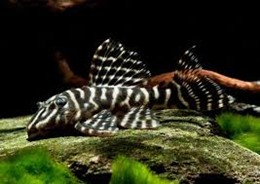COLOMBIAN ZEBRA PLECO (L-129 – HYPANCISTRUS DEBILITTERA)
$28.00
Full Description
Hypancistrus debilittera – Colombian Zebra Pleco – L129
Hypancistrus debilittera was described in 2007 by Armbruster, Lujan & Taphorn. Their common name is Colombian Zebra Pleco. They somewhat resemble the Hypancistrus Zebra, the best-known species in this genus. This common name is a bit confusing because they come from Venezuela. They were probably exported from Colombia, which gave rise to this name.
Before they were officially described, they were given the temporary number L129. Although the number officially expires after they are officially described, shops and hobbyists often still use the number.
Hypancistrus debilittera belongs to the Loricariidae or Armored Catfish family. This family contains about 1000 described species, but numerous species have not yet been described. The genus Hypancistrus currently only has about eight species.
Description
The Colombian Zebra Pleco does not grow larger than about seven to eight centimeters in total length. The ground color is dark brown. The dark brown is interrupted by a number of light stripes on both the body and the fins. These stripes can be off-white to yellow in color.
Hypancistrus debilittera is not aggressive as long as there is sufficient space, and more importantly, hiding places: at least one per specimen. Like all other species from the Hypancistrus genus, it is recommended to keep this species in a small group, because then a more natural behavior is displayed and they feel more comfortable.
However, if there is not enough space or there are too few shelters, fierce fights can break out, and they can certainly be injured!
Diet
A quick look at the teeth of this catfish reveals that we are dealing with a carnivore. This Pleco likes to feast on food such as shrimp, krill, mussels, pieces of raw fish, bloodworms and mosquito larvae and sinking food tablets for carnivores. Once acclimatized, this fish will often also consume vegetable foods such as algae/catfish tablets, and in some cases also fresh vegetables such as cucumber, zucchini, eggplant, lettuce, yam, potato and carrot.
This species is not suitable as an algae cleaner due to its mainly carnivorous nature.
Origin
South America: Rio Bito, tributary of the Rio Orinoco, upstream at Puerto Careño, Colombia
The Aquarium
This small catfish prefers a dimmed aquarium with plenty of hiding places, in the form of plants, driftwood, rocks, and/or artificial caves. To keep several specimens of this species, or to keep this species together with other bottom dwellers, an aquarium of 100×40 centimeters is required, as the species can be quite territorial, and in the absence of shelters the Colombian Zebra Pleco can become quite aggressive towards other bottom dwellers. If it is the only bottom dweller in the aquarium, an aquarium of 80×35 centimeters is sufficient, but it does best in the company of a few conspecifics.
This species does best in soft, slightly acidic to neutral water (pH 6-7.5 and dH 2.0-15.0), richly oxygenated and with plenty of current. A strong filter is important, as this fish produces a lot of waste.
Temperature: 23-28°C
pH: 5.5-7.5
Breeding Hypancistrus debilittera – Colombian Zebra Pleco
Ideal breeding conditions for this species include fast-flowing, warm water (28-30 degrees Celsius) with high oxygen levels. The latter can be achieved using a diffuser connected to a filter or flow pump (an extension of the outflow that adds air to the water), or by placing the outflow of one of the filters at surface level, so that the water surface is broken and exchange of gases can take place (CO2 is exchanged for oxygen). The aquarium should be equipped with artificial breeding caves (or something similar made of rocks/driftwood). The entrance must be provided with a strong current. The ideal distribution of sexes is 2 or 3 females per male.
Comments
This species, scientifically described in early 2007 by J.W. Armbruster, N.K. Lujan and D.C. Taphorn, is often confused with other similarly marked and small-growing Hypancistrus species found elsewhere in tropical South America.
4 in stock

